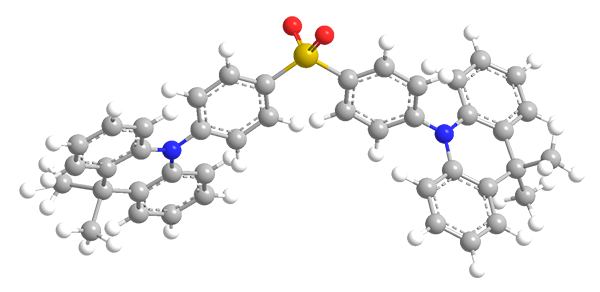What molecule am I?


Organic light-emitting diodes (OLEDs) are now all the rage for electronic displays. Researchers have been working on OLEDs for many years; but now the technology is going commercial, mostly in mobile phones, but also in TVs like some manufactured by Korean giant LG Corp.
What are the advantages of OLEDs over conventional inorganic LEDs? According to Guillaume Chansin, senior technology analyst at IDTechEx, an international market research and consulting firm, “OLED displays can be lighter, they can be flexible, and they allow designers more leeway with the shape of their devices.” He adds that OLEDs can be far more energy-efficient than the LCDs found in most TVs today; and because they are now manufactured on plastic substrates instead of glass ones, “OLED displays can make phone screens shatterproof, or even foldable.”
So where does our molecule come in? “Diphenylsulfone dimethyldihydroacridine”, formally 10,10’-(sulfonyldi-4,1-phenylene)bis[9,10-dihydro-9,9-dimethylacridine], is a blue light–emitting OLED that was developed by Chihaya Adachi and colleagues at Kyushu University (Fukuoka, Japan). The fluorescent OLED is less expensive and more quantum-efficient than earlier blue light emitters. Its performance compares well with that of the current generation of phosphorescence-based OLEDs.

Learn more about this molecule from CAS, the most authoritative and comprehensive source for chemical information.
Molecule of the Week needs your suggestions!
If your favorite molecule is not in our archive, please send us a message. The molecule can be notable for its current or historical importance or for any quirky reason. Thank you!
Stay Ahead of the Chemistry Curve
Learn how ACS can help you stay ahead in the world of chemistry.

